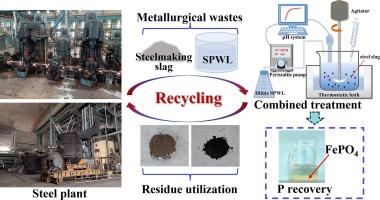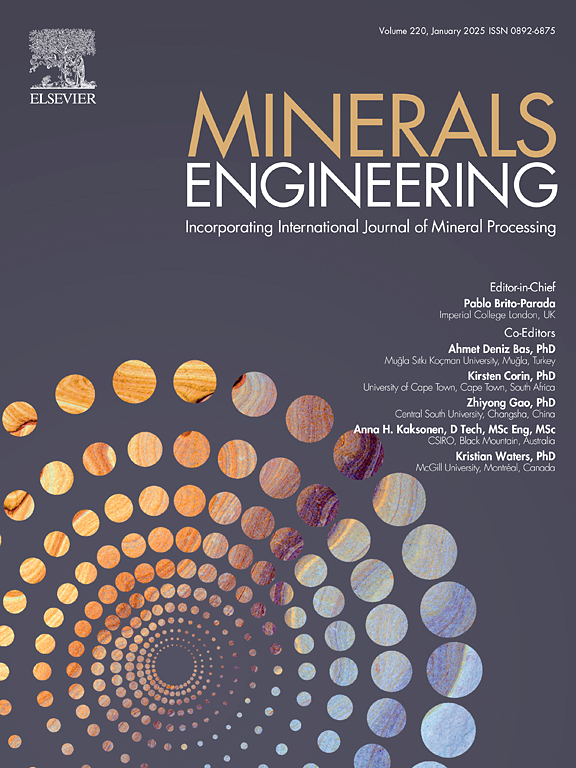Phosphorus removal from steelmaking slag by selective leaching in the steel pickling waste liquor
IF 4.9
2区 工程技术
Q1 ENGINEERING, CHEMICAL
引用次数: 0
Abstract
Steelmaking slag and steel pickling waste liquor (SPWL) are two kinds of by-products in steel plants. The existence of phosphorus (P) in steelmaking slag is the main factor affecting its reuse within the steelmaking process. To remove P from steelmaking slag with a low-cost method, selective leaching was proposed by using SPWL as a leaching agent. SPWL generally contains a small amount of Fe3+ ions, and thus the effect of Fe3+ content in SPWL on the dissolution behavior (especially P element) of steelmaking slag was investigated, as well as the pH value and steelmaking slag type. The dissolution ratios of P from various slags in the SPWL containing 500 ppm Fe3+ exceeded 95 % at pH 1.5 while those of Fe, Mn, and Al were very low, exhibiting satisfied selective leaching of P. Increasing pH value and Fe3+ content (in SPWL) resulted in a decreasing P dissolution ratio while exerting an insignificant effect on the dissolution of other elements. The FeHPO4+ was predicted as the predominant species during leaching and the transformation of FeHPO4+ to FePO4 could be present. When the SPWL containing 800 ppm Fe3+ was used, FePO4 was observed in the residues after leaching at pH 2.0, resulting in a worse removal of P from slag. However, the residues including massive valuable components had an extremely low P content after leaching in the SPWL containing 500 ppm Fe3+ at pH 1.5, which can be used as a flux in the metallurgical process. To ensure a high P removal rate from steelmaking slag and to prevent FePO4 precipitation during leaching, a relatively low pH and Fe3+ content in the SPWL are necessary.

在钢铁酸洗废液中通过选择性浸出去除炼钢渣中的磷
炼钢废渣和钢铁酸洗废液(SPWL)是钢铁厂的两种副产品。炼钢废渣中磷(P)的存在是影响其在炼钢过程中再利用的主要因素。为了以低成本的方法去除炼钢渣中的磷,有人提出使用 SPWL 作为浸出剂进行选择性浸出。SPWL 通常含有少量 Fe3+ 离子,因此研究了 SPWL 中 Fe3+ 含量对炼钢渣溶解行为(尤其是 P 元素)的影响,以及 pH 值和炼钢渣类型。在 pH 值为 1.5 时,含有 500 ppm Fe3+ 的 SPWL 中各种炉渣中 P 元素的溶出率超过 95%,而 Fe、Mn 和 Al 元素的溶出率则非常低,这表明 P 元素的选择性浸出得到了满足。据预测,FeHPO4+ 是浸出过程中的主要物种,可能存在 FeHPO4+ 向 FePO4 的转化。当使用含 800 ppm Fe3+ 的 SPWL 时,在 pH 值为 2.0 的浸出条件下,残渣中出现了 FePO4,导致矿渣中 P 的去除率降低。然而,在 pH 值为 1.5、含 500 ppm Fe3+ 的 SPWL 中浸出后,残渣(包括大量有价值成分)中的 P 含量极低,可用作冶金过程中的助熔剂。为了确保炼钢渣中 P 的高去除率,并防止在浸出过程中产生 FePO4 沉淀,SPWL 中的 pH 值和 Fe3+ 含量必须相对较低。
本文章由计算机程序翻译,如有差异,请以英文原文为准。
求助全文
约1分钟内获得全文
求助全文
来源期刊

Minerals Engineering
工程技术-工程:化工
CiteScore
8.70
自引率
18.80%
发文量
519
审稿时长
81 days
期刊介绍:
The purpose of the journal is to provide for the rapid publication of topical papers featuring the latest developments in the allied fields of mineral processing and extractive metallurgy. Its wide ranging coverage of research and practical (operating) topics includes physical separation methods, such as comminution, flotation concentration and dewatering, chemical methods such as bio-, hydro-, and electro-metallurgy, analytical techniques, process control, simulation and instrumentation, and mineralogical aspects of processing. Environmental issues, particularly those pertaining to sustainable development, will also be strongly covered.
 求助内容:
求助内容: 应助结果提醒方式:
应助结果提醒方式:


